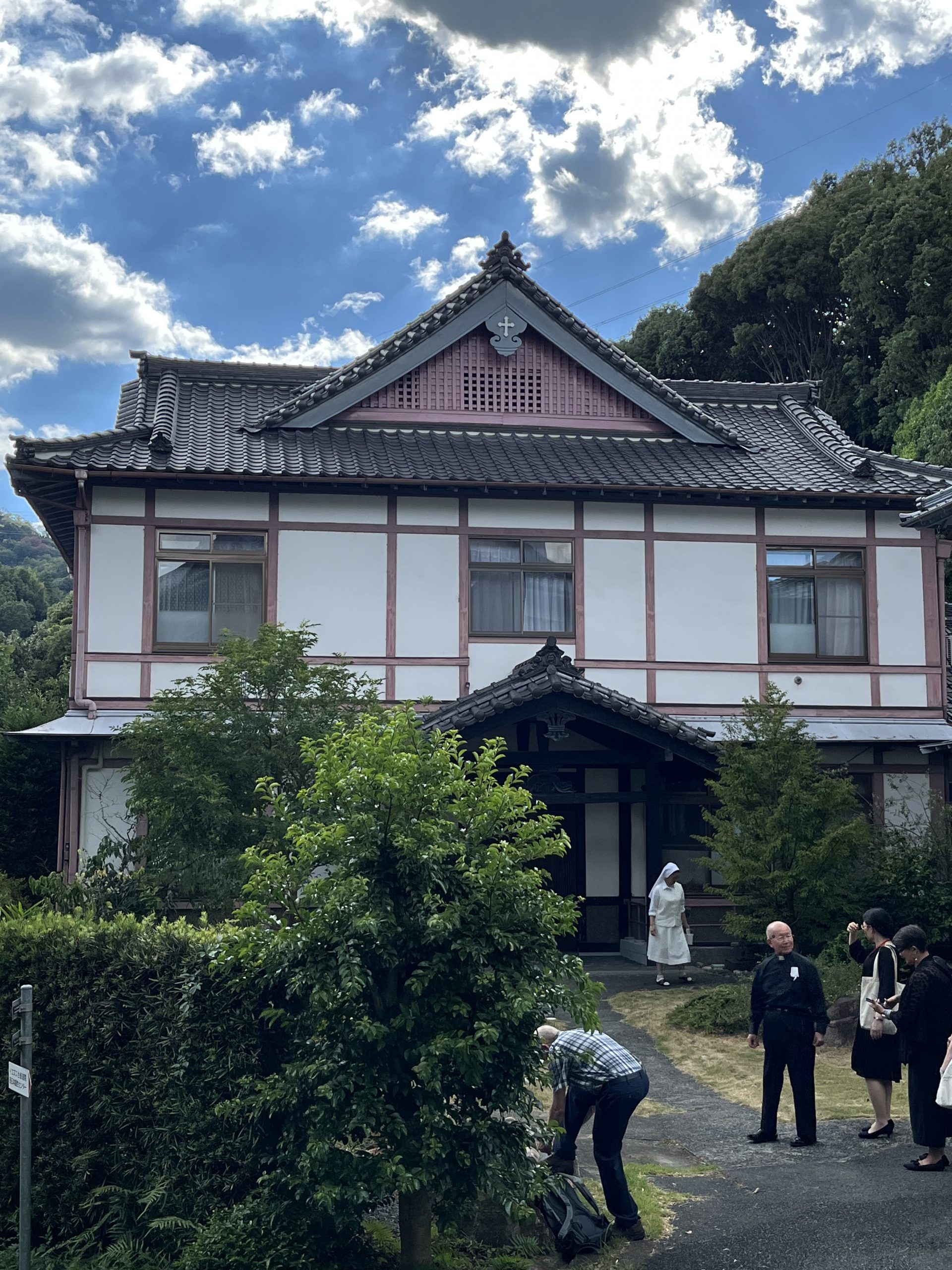After the morning Memorial Ceremonies, we had a short break and then saw a few more sights here in Hiroshima today.
Our first stop was a local parish, Gion Catholic Church, where we watched a short movie about the Jesuit Novitiate at the time of the atomic bombing in 1945. Fr. Pedro Arrupe, sj was the Rector and Novice Director at the time. I believe there were four priests and a few others living there at the time. More on this in a moment.
The pastor and parishioners at Gion Catholic parish fed us lunch. On another brutally hot day, it was a delightful summer meal, cool, refreshing and filling. Honestly, the Japanese food during this past week has been delicious, a true experience of artful presentation, and a great way to experience their culture. We have also benefited from tremendously warm hospitality everywhere we go.
 This is another parish staffed by the Jesuits. I know from speaking with several of the Japanese bishops at dinner last night that they could not begin to staff their parishes without the assistance of missionary priests. In fact, one of the Bishops of Japan is Filipino, one is a Claretian (Congregation of Missionary Sons of the Immaculate Heart of the Blessed Virgin Mary) from Catalonia, Spain, and one is even an American Capuchin. That is considerable, given that there are only 16 dioceses in all of Japan.
This is another parish staffed by the Jesuits. I know from speaking with several of the Japanese bishops at dinner last night that they could not begin to staff their parishes without the assistance of missionary priests. In fact, one of the Bishops of Japan is Filipino, one is a Claretian (Congregation of Missionary Sons of the Immaculate Heart of the Blessed Virgin Mary) from Catalonia, Spain, and one is even an American Capuchin. That is considerable, given that there are only 16 dioceses in all of Japan.
After our visit to the parish of Gion Catholic Church, our group of pilgrims moved on to Nagatsuka, which was a Jesuit novitiate at the time of the bombing in 1945. Today it serves primarily as a retreat center. In 1945, Fr. Pedro Arrupe, sj was the Rector and Novice Master. He later became the General Superior of the Society of Jesus. Just so you understand, Fr. Arrupe’s cause for sanctification has been introduced. The one building from 1945 is still standing today along with a few others.
 We had an informative tour of this Jesuit building, and heard the story of the Jesuits on August 6, 1945 from a delightful Jesuit priest, Fr. Keisaku Shionoya. We saw the room where Fr. Arrupe lived and saw where so many of the victims of the bombing were laid and cared for. We then went to the chapel and celebrated Mass with our group and a few others who were completing a retreat.
We had an informative tour of this Jesuit building, and heard the story of the Jesuits on August 6, 1945 from a delightful Jesuit priest, Fr. Keisaku Shionoya. We saw the room where Fr. Arrupe lived and saw where so many of the victims of the bombing were laid and cared for. We then went to the chapel and celebrated Mass with our group and a few others who were completing a retreat.
After Mass we met a priest whose family is from Seattle as well as a couple now living in Seattle. Always nice to run into the ‘locals’ while traveling abroad!
On the day of the bombing, there were four priests living in the residence along with a few others. Nagatsuka is approximately 5 kilometers from the bomb sight. Miraculously, the priests in the house were mostly unharmed, and none of them ever tested positive at any time all the years later for radiation poisoning.
They can see the clouds and smoke arising from the city, and the fires that continue to grow. Many people with horrendous burns, bleeding, begin to make their way up from the valley to their home. They begin to treat the wounded, and soon they run out of bandages and drugs, and the home is overwhelmed with the number of people needing assistance.
Late in the day, in an effort to organize much needed help, Fr. Arrupe saw the devastation of Hiroshima down in the valley and took the priests to begin assisting victims and to search for their companions who lived in the city. What would normally have been a two hour trip took twelve to find their companions and return with them to the Novitiate. Early the next morning, Fr. Arrupe celebrated Mass with the wounded crowded all over the chapel and the rest of the Novitiate.
A significantly high percentage of those who received treatment at Nagatsuka survived. I believe the last victim left the home in the Spring of 1946. Again, the stories of devastation, suffering and death are as heart-wrenching as the story of Fr. Arrupe and his Jesuit companions is inspiring.
How can we learn the lessons of that day? We must!
10














